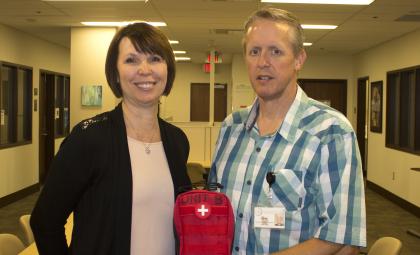It's All in the Kit

Niagara Health’s Suicide Attempt Response Kits Equip Staff to Save Lives
December 12, 2018
It’s a zippered pouch with a face shield, non-latex gloves, pressure dressing, and a few other materials. At first you might think you’re holding a standard first-aid kit but then you notice the wire cutters, the ResQhook, and the EMS shears. At Niagara Health this unique kit is part of an innovative solution to mitigate the risk around attempted suicide and save patient lives.
It was a critical incident at Niagara’s inpatient unit in 2017 that led Barb Pizzingrilli and her team to rethink their response strategy. As Director, Patient Care Mental Health & Addictions, Pizzingrilli went through a detailed quality review, led by the organization’s Quality and Patient Safety Team.
“When a patient would make an attempt with ligature or cutting,” explained Derek Christensen, Regional Educator, “staff would literally have to leave the patient to go retrieve the material they needed.” And depending on the material the patient used to tie or cut, it could be hard to find the right tools.
As a member of Canada’s Army Reserve, Christensen observed that every reserve soldier has a zippered first-aid pouch on them at all times – one that is easy to access with separate pouches. “It hit me that we could use this model to create our own suicide attempt response kits,” he said.
According to both Pizzingrilli and Christensen, the kits had to be diverse and incorporate supplies to help cut through tough materials and any number of knots, without causing harm to the patient. That’s where the EMS shears and the wire cutters come in.
Pizzingrilli’s team recently put the kits in action. Similar to a crash cart, the kits will be readily available in the inpatient units as well as outpatient – anywhere suicide attempts can take place. “The security staff have also requested to have a kit made available to them,” said Pizzingrilli. The team plans to arrange formal training for staff on the use of the kits.
Minimizing harm
For Pizzingrilli it’s essential that she and the team have a good relationship with the Risk Management department. Each time they meet to review HIROC’s annual Risk Assessment Checklists (RAC) self-assessment program, it helps identify risk opportunities and mitigation strategies in the department and across the organization.
Connected with the RAC program are Risk Reference Sheets. A Risk Reference Sheet has been created for each of the top risks in the HIROC claims database. Risk Reference Sheets are broken down by facility type, with 14 documents devoted solely to mental health. A description of the risk, common claim themes, case studies, and key mitigation strategies are included on each sheet. “Reviewing the incident trends and the Risk Reference Sheet on suicide helped us determine that we needed something like these kits in the hospital,” said Caroline Smith, Senior Risk Management Specialist.
Smith and Pizzingrilli understand that they can’t fully eliminate risk in healthcare. However, their motivation comes from finding solutions so that if something does happen, they can ensure a safe outcome and minimize harm to the patient or staff member. The suicide attempt response kits are designed to do just that – equip staff to save lives.
“Many of the clients we deal with are young and are just starting their lives,” says Pizzingrilli. “If we can make a difference in their care and get them back on track, that’s what matters.”
Michelle Holden is Communications and Marketing Specialist, HIROC
For HIROC subscribers with questions about RAC and how it can be applied to your organization – please reach out to us at [email protected].